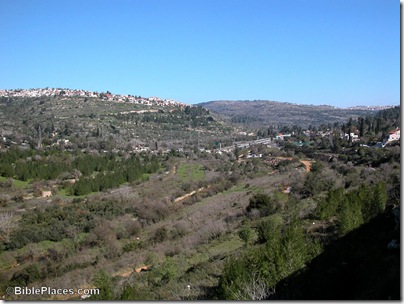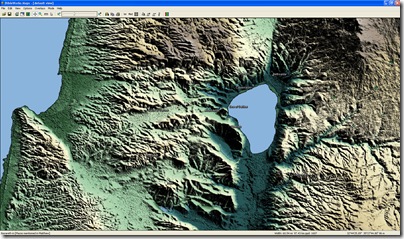Yahoo has many photos of last night’s total lunar eclipse, including a number of pictures taken in Jerusalem.
Normally Biblical Archaeology Review posts only the introductions to their articles online (unless you’re a premier member), but the March/April issue is now available to all in its entirety. There are a number of interesting articles, but instead of listing them here, you can click over yourself.
I offer only a comment on one article here: I think that Shanks’ article on Emmaus is well-written, but he comes to the wrong conclusion. I think that he wanted to write an article on the site at Latrun (formerly known as Emmaus and Nicopolis) and this pushed him to adopt this as the location of Emmaus of Luke 24. While he recognizes the problems with this site (namely the inferior textual evidence and the lengthy distance to walk in a day), he dismisses them too quickly. He never discusses any of the evidence for Motza/Moza/Colonieh. Nor does anyone dispute that the Latrun site was known as Emmaus in the 1st century. The issue is was this the Emmaus that Luke referred to, and I think the evidence makes this an unlikely candidate.
Another view is that of J. Carl Laney, given in a chapter of his doctoral dissertation. With his permission I have digitized this chapter and posted it online (pdf). Though the discussion is briefer, I prefer Notley’s conclusion on page 368 of The Sacred Bridge. For now, I have to leave it at that. I think all would agree that the issue is difficult. I appreciate BAS making this issue available for all to read and discuss.
One of the best Bible software programs for the PC is BibleWorks 7. If you’re only interested in reading the Bible and doing simple searches, this program is more than you need. But those who know, or plan to learn, the original languages will find a wealth of capabilities available at lightning speed. The powerful “Copy Center” makes it fast and easy to copy and paste multiple translations – any number, any versions – in a single click. This would have saved me a lot of time on a recent study. The right-click context menus are also easy to use. If you’re still learning Greek and Hebrew (or haven’t started yet), the built-in flashcard module has plenty of options which makes it easy to quiz yourself. At $350, the program is not inexpensive, but browsing through the list of works included in the copyright list will make you wonder how the software can cost so little.
will find a wealth of capabilities available at lightning speed. The powerful “Copy Center” makes it fast and easy to copy and paste multiple translations – any number, any versions – in a single click. This would have saved me a lot of time on a recent study. The right-click context menus are also easy to use. If you’re still learning Greek and Hebrew (or haven’t started yet), the built-in flashcard module has plenty of options which makes it easy to quiz yourself. At $350, the program is not inexpensive, but browsing through the list of works included in the copyright list will make you wonder how the software can cost so little.
Version 7 added a map module, and BibleWorks sent me a review copy of the program to evaluate this new feature. I love the integration of the map module; simply right-click on a site name and choose “Lookup in BibleWorks Maps” to get a list of relevant maps to open. Teachers will find this a handy way to access a map while in the middle of a course without having to use other software. The module includes a variety of terrains that you can load, including Landsat data, and some are more aesthetically pleasing than others. Unfortunately, the map data has significant shortcomings; it reminds me more of a beta program. BibleWorks has a major revision of the map module underway which I expect will solve many of the labeling problems. One problem that exists with both the map module and the program in general is that while the documentation is extensive, the features are not always intuitive. This means the happiest user will be the one who reads first and plays second. If you never read any of the documentation, you’ll probably miss many of the features and spend too much time in frustration. Would I recommend the program? Absolutely. Would I recommend its purchase primarily for the map module? Not yet. With their policy of free upgrades within a version, any existing user will be able to download all of the updates as they are released.
- Tagged Resources
The teaser is now out. The movie, entitled “Indiana Jones and the Kingdom of the Crystal Skull” comes out on May 22. Wikipedia has details about the filming and there’s always the official website with a running countdown. It’s been 19 years since Indiana last helped us understand how archaeology really works.
HT: Paleojudaica
Eisenbrauns has hosted the first (and possibly last) “Ancient Near Eastern Valentine Contest.” The entrants even provided translations, in case you do not know Luwian, Hurrian-Hittite, Sumerian, Hebrew, Greek, or Egyptian.
Antonio Lombatti has word of reports of (recent) excavations of Magdala and (not-so-recent) excavations of the area now known as “Nazareth Village.”
Magdala: You can read Lombatti’s intro here (with beautiful photos) or read the report in Italian here. If you’re wondering if you’ve ever visited Magdala, you haven’t. You may have driven by it (or possibly hiked or biked if you’re one of those sort), but the area has been locked and sealed for a long time, and entrance available only to those who know the right people. Hopefully that will all change…
Nazareth: You can read Lombatti’s intro here or go straight to the report (pdf) by Stephen Pfann. If you’re wondering why you were unimpressed with Nazareth when you visited, it’s probably because you didn’t visit Nazareth Village, a modern reconstruction of the 1st century village.
- Tagged Discoveries
Search
About the BiblePlaces Blog
The BiblePlaces Blog provides updates and analysis of the latest in biblical archaeology, history, and geography. Unless otherwise noted, the posts are written by Todd Bolen, PhD, Professor of Biblical Studies at The Master’s University.
Subscribe
Tags
10th Century
American Colony Photos
Analysis
Antiquities Trade
Dead Sea
Dead Sea Scrolls
Discoveries
Egypt
Excavations
Forgery
Galilee
Greece
Holidays
Israel's Coast
Italy
Jerusalem
Jezreel Valley
Jordan
Jordan Rift
Judah
Lebanon
Lectures
Mediterranean Islands
Mesopotamia
Museums
Negev
New Exhibits
Persia
Philistines
Photo Resources
Picture of the Week
Pseudo-Archaeology
Resources
Sad News
Samaria
Shephelah
Syria
Technology
Temple Mount
Tomb of Jesus
Tourism
Travels
Turkey
Weather
Weekend Roundup
Links
Notice
As an Amazon Associate we earn from qualifying purchases. In any case, we will provide honest advice.


